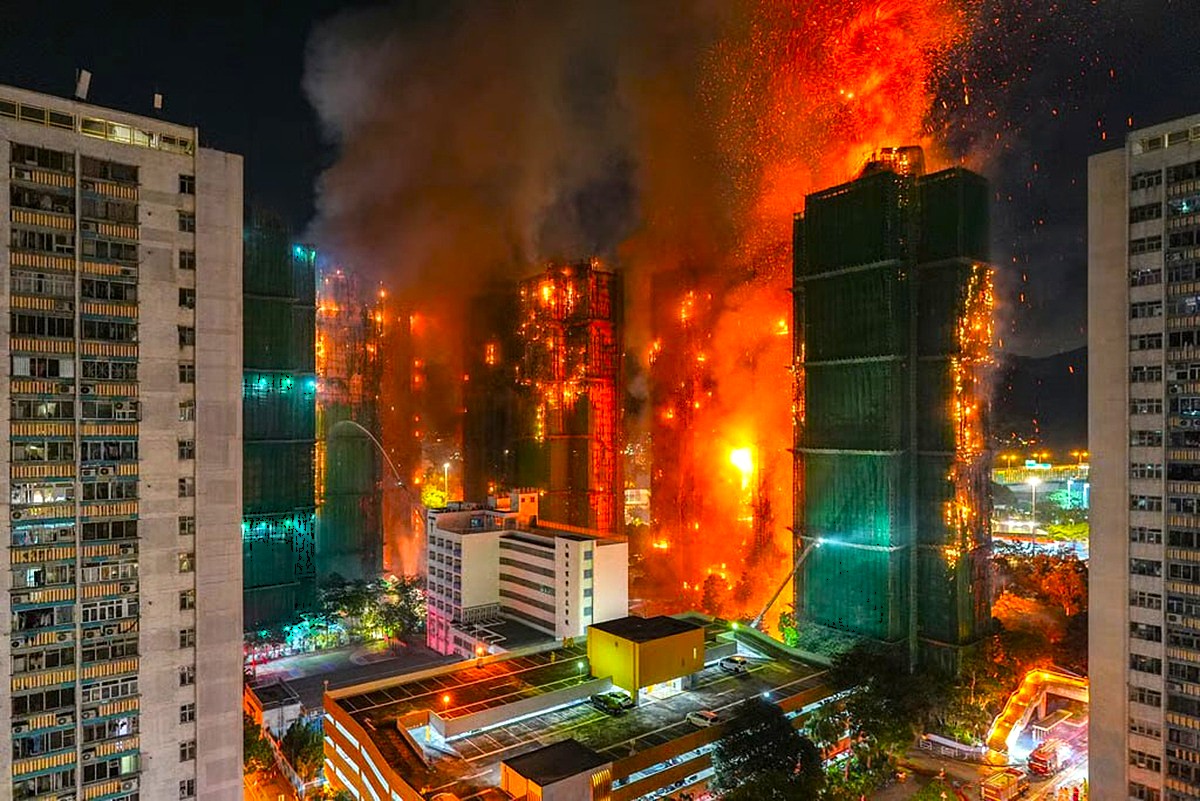Straight to the point: the fire that tore through a high-rise apartment complex in Wang Fuk Court, Hong Kong, has killed at least 44 people and left 279 reported missing. It’s now the deadliest fire in Hong Kong in decades.
Key Takeaways
- Death toll stands at 44, with 279 people unaccounted for and dozens hospitalized.
- Fire swept rapidly through seven of eight residential towers at Wang Fuk Court — aided by flammable, non-compliant external materials used during renovation.
- Three men have been arrested — two directors and an engineering consultant from the renovation firm — on suspicion of gross negligence / manslaughter.
- The blaze has triggered intense scrutiny over building-safety practices and emergency preparedness in Hong Kong high-rises.
What Happened — The Unfolding of the Tragedy
The Fire and Its Spread
On 26 November 2025, around 14:51 (local time), a fire broke out in Wang Fuk Court, a public-housing estate in the northern Tai Po District of Hong Kong.
The fire started on bamboo scaffolding and green mesh — installed for renovation works that began July 2024.
From there, flames spread swiftly — aided by wind and exterior materials that failed fire-resistance standards (including plastic sheeting and Styrofoam).
Within hours, seven of the eight towers were engulfed. The fire department raised the alert to Level 5, the most severe classification.
The Vulnerabilities: Renovation Gone Wrong
Wang Fuk Court had nearly 2,000 flats housing around 4,800 people.
During renovation, builders used bamboo scaffolding, green mesh, plastic sheets, and Styrofoam around windows — none of which met fire-safe standards under Hong Kong’s emergency building regulations.
Investigators say these materials allowed fire to spread unusually fast, jumping between floors and buildings.
Critically, many residents reportedly didn’t hear alarms — some windows were sealed shut during maintenance, trapping people inside as smoke spread.
Fallout: Arrests, Investigations, and Political Ripples
- Three men arrested — two directors and a renovation firm engineering consultant — charged with manslaughter and gross negligence.
- Local leader John Lee Ka-chiu called it a “massive catastrophe”. The government has launched a full-scale criminal and safety compliance investigation.
- Nearly 900 people displaced — moved to temporary shelters. Public anger is growing over building-safety oversight.
- The timing — just ahead of upcoming local legislative elections — has already triggered concern that public safety, housing standards, and housing-policy failures could shake voter confidence.
Why This Fire Is a Wake-Up Call
High-Rise Living: Hidden Risks Exposed
Hong Kong is one of the most densely populated cities globally. Many people live in high-rise towers, including aging buildings built decades ago. In such environments:
- Any lapse in renovation safety can quickly become disastrous.
- External maintenance (scaffolding, nets, meshes) — if done with substandard materials — can turn these towers into fire traps.
- Evacuation is difficult: narrow stairwells, reliance on elevators, and often limited windows or blocked exits make high-rises uniquely vulnerable.
This tragedy shows how quickly neglect — cost-cutting, lax oversight — turns into human catastrophe.
Regulatory & Urban-Planning Implications
Officials in Hong Kong now face a reckoning:
- How many other residential estates use similar flammable materials for renovation?
- Are fire-safety audits and building-material inspections frequent and strict enough?
- Do high-rise communities have proper evacuation plans — alarms, accessible exits, fire drills — especially during renovation?
Given rising public concerns, governments may tighten building regulations, enforce mandatory use of fire-resistant materials, and potentially re-inspect many housing estates across the city.
What This Means for Residents and the Global Urban Community
For residents of high-density cities like Hong Kong — and for urban planners worldwide — this fire drives home some painful lessons:
- Renovations should never compromise safety. Cutting corners on materials or using cheaper scaffolding can endanger thousands.
- Transparent oversight and regular safety audits are non-negotiable. For housing estates especially.
- Community awareness matters: fire drills, accessible exits, and ensuring alarms and windows remain unblocked even during construction.
In short — you can’t treat human lives as saving opportunities when shaving renovation budgets.
FAQs
A: As of the latest reports, several buildings are still being searched; 279 people remain missing. Rescue and investigation operations are ongoing.
A: Fire started on bamboo scaffolding around one building undergoing renovation and spread via flammable mesh, plastic sheeting, and Styrofoam used on external walls/windows — materials that failed fire-resistance standards. Wind and close proximity of towers worsened the spread.
A: Police arrested three men — two directors and an engineering consultant of the renovation firm — on suspicion of gross negligence and manslaughter. Full criminal and safety-compliance investigations are underway.









